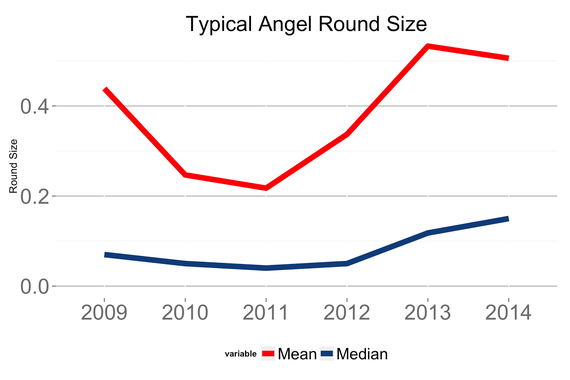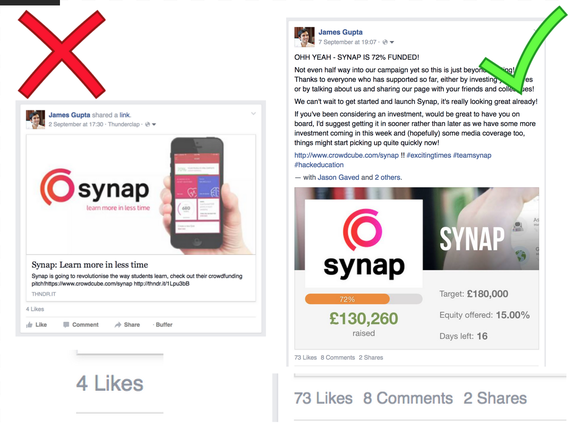When it comes to raising seed investment for your startup, Crowdfunding, is all the rage right now. But what exactly is it, what are the advantages and disadvantages of this new and relatively untrodden route, and how can you increase your chances of success? Having raised £200,000 for my own company, Synaphttp://synap.ac last month, I thought I'd share some of my top tips for success!
US giants Kickstarter and Indiegogo may be the first companies that spring to mind when you mention 'crowdfunding' -- these platforms have enabled entrepreneurs, engineers and developers to bring their ideas to market by pitching directly to their target audience and basically saying 'alright, who wants one?'. But the UK is leading the way in a slightly different model: equity based crowdfunding. Sites like Crowdcube and Seedrs allow entrepreneurs to crowdsource potential investors for their ideas, allowing 'the crowd' to become shareholders in their company for as little as £10.
The concept is both revolutionary and inevitable at the same time. It's revolutionary because it is disrupting the traditional 'top down' model of investment -- allowing companies to raise investment by going directly to the crowd rather than seeking finance from loans of private investment. It's inevitable because, this is exactly what The Internet has been doing since it's inception: disrupting and democratising old business models and putting 'the crowd' in direct control of them. Crowdfunding was also inevitable given the gradual rise in startups' funding requirements. Over the last few years, the size of the average seed round has been increasing -- perhaps owing to increased competition and the need to rapidly scale an idea, though angel investors' wallets haven't necessarily got any thicker, and (at least in the UK), VC's are reluctant to make investments in very early stage companies, instead preferring to enter around a Series A round when a company fits their investment criteria better. This creates a funding gap, and Crowdfunding has stepped in to fill it by allowing multiple angel investors, as well as members of the public who would not traditionally call themselves 'investors' at all, to step in and get involved in the fast moving world of early stage investing.

Crowdfunding is not, however, an 'easy' way of getting funding -- it requires a lot of time and effort, and a significant percentage of companies fail to reach their target, which sadly mean they do not raise any money at all. I'm currently 76% through my own crowdfunding campaign, so whilst I'm by no means an 'expert' on this topic, I do have a few tips we've picked up along the way that I'd like to share. In two weeks, if we fail to hit our target, then feel free to ignore them!
Tip 1: Prepare for a 3 or 4 month process
Your crowdfunding campaign will typically last for 30 days -- but there's a lot of work and preparation to do before you get to that stage! You'll need to produce a business plan, financial forecast, pitch deck, pitch video and referenced text for your campaign page -- this process takes time and a lot of back and forth with the team at whichever platform you're using in order to get it right!

Oh -- if you're offering EIS or SEIS shares (which, if you're not, you should have a very good reason why because it's a fantastic scheme!) then apply for an Advance Assurance as to your eligibility from HMRC in advance! It can take up to 6 weeks and you don't want something like that to hold up your campaign going live.
Tip 2: Arrange at least 30% of your investment off site
About half of all crowdfunding campaigns fail to meet their target -- and this is especially so for startups who do not usually have a huge following of investors behind them. Arranging around 30% of your investment offline, so that people who have already agreed to invest can do so as soon as your pitch launches, you create an initial momentum behind your campaign, and build up social proof quickly: ironically, the better your pitch is already doing, the more likely other people are to invest in it!
Tip 3: Set up physical events to promote your campaign
It may be 2015, but people still do business with people. There is only so much you can communicate about your idea over the internet -- it's important that potential investors have the chance to meet you face to face, where you can answer questions on a more personal basis and they can see your team's passion for what you do. Organise physical events during your campaign to give people this opportunity, and to get people talking about your campaign.

Tip 4: Use your personal network, but don't abuse it!
There's always a tricky balance to be struck between asking your friends for help and shameless self promotion! At the end of the day though, who doesn't use their social networks for some kind of self promotion at some point? Whether it's asking people to download your band's latest EP or vote in a competition, we practically all do it, and whilst it can be annoying at times, who can blame someone for just asking their friends for support in pursuing something they're passionate about?
When it comes to social media promotion, there are good and bad ways to do it! Obviously don't over do it, especially on Facebook where people don't come to look at business related posts, but do definitely reach out to all of your networks every so often -- you never know who might be a potential investor or at least, who might know a potential investor. Quick advice: when you do post, make it personal! Remind people that you're not talking to them as a brand, you're reaching out to them as a friend -- it can have a huge impact on your results (see below for the differences between a cookie-cutter and a personalised message!)

Tip 5: Reply to business plan requests ASAP
On one hand this is obvious because, of course you should reply to potential investors as soon as possible! However, there's a specific reason why you should try to respond within the first few minutes if at all possible. When most people request your business plan, it will be a spontaneous or impulse decision -- by replying almost instantly, you're catching them when they're still engaged with your pitch, making it more likely they're going to read it there and then and reply to you. If you leave it for a few hours or a day, they will probably still read it at some point, but you have a much higher chance of being lost in their inbox and forgotten about.
Tip 6: Progress on crowdfunding isn't linear
This is a well documented phenomenon, and I can certainly attest to it in my own experience. Crowdfunding campaigns typically have a strong 'start', followed by a lull in the middle, and a final surge as everyone rushes to invest in the last few days. This isn't always the case: some campaigns never pick up momentum at all, and others (usually ones backed by huge media campaigns or founded by celebrity chefs) hit their target in a matter of days, but for most normal campaigns, this is the way it works.
And it makes sense when you think about it: if someone tells you that you have to do something at some point in the next 30 days, when are you most likely to do it? Day 29, right? Keep momentum in your campaign going as much as possible, and encourage people who have already made their decision to invest sooner, rather than later to try and overcome this.

Tip 7: Appeal to different 'investor types'
If you were preparing a pitch for a specific angel investor or VC firm, you could do a fair deal of due diligence and research into their background, what deals they'd done in the past and the way they evaluate opportunities. Everyone has their own method, and there are ways of tailoring your pitch to different types of investor -- for example, some are very number focused and will evaluate your business largely based on its projected revenue, profit and cashflow. Others focus on the team behind a product, asking simply can they deliver what they say they're going to, and others are all about the idea itself, and whether it has potential to become the 'next big thing' a-la Facebook, Uber or AirBnB.

With crowdfunding, your pitch is going out to a huge range of people, and it's impossible to tailor something that's perfect for all of them. Make sure your pitch covers all the main bases, and then try to follow up with more information in a meeting or phone call as soon as possible after so that you can discuss in a bit more detail.
Tip 8: It doesn't count until it's in
Whilst your campaign is running, it's going to be the #1 most important, stressful and exciting thing going on in your life, all at the same time! When something takes over your mind like that, it's very easy to forget that to other people, it doesn't have the same status. Your potential investors have other things going on which take priority, so even if they say 'I'll definitely invest tomorrow', remember there's a fairly decent chance they might forget or let it slip for a few days. Don't count on anything until it's committed into your campaign, and practice the art of politely nudging people!
Summary
Crowdfunding is an incredibly exciting new way to raise money for your business. In the future, we could see it disrupt traditional models of finance completely. Right now, however, it's in its infancy and finding its feet. Creating a successful crowdfunding campaign requires a lot of up front planning and work on your part to make sure you keep the momentum going.
James is the Founder & CEO of Synap, an online education platform that uses AI algorithms and psychology research to enhance the way students and professionals learn.